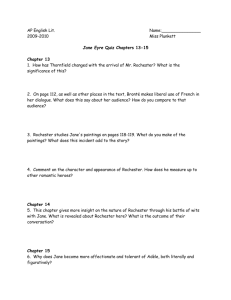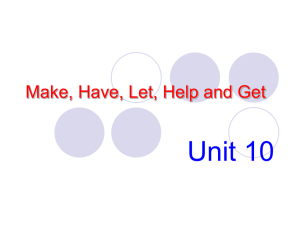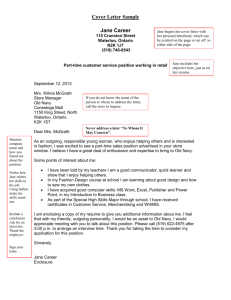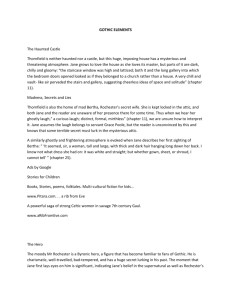Jane Eyre extended reading guide for BONUS
advertisement
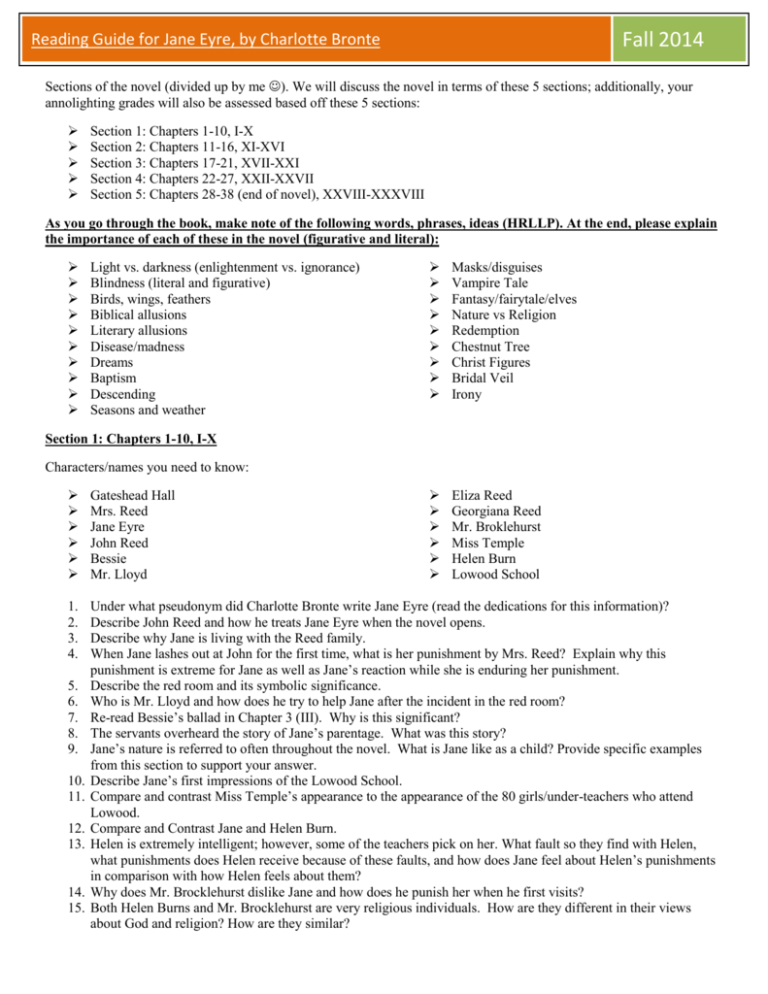
Fall 2014 Reading Guide for Jane Eyre, by Charlotte Bronte Sections of the novel (divided up by me ). We will discuss the novel in terms of these 5 sections; additionally, your annolighting grades will also be assessed based off these 5 sections: Section 1: Chapters 1-10, I-X Section 2: Chapters 11-16, XI-XVI Section 3: Chapters 17-21, XVII-XXI Section 4: Chapters 22-27, XXII-XXVII Section 5: Chapters 28-38 (end of novel), XXVIII-XXXVIII As you go through the book, make note of the following words, phrases, ideas (HRLLP). At the end, please explain the importance of each of these in the novel (figurative and literal): Light vs. darkness (enlightenment vs. ignorance) Blindness (literal and figurative) Birds, wings, feathers Biblical allusions Literary allusions Disease/madness Dreams Baptism Descending Seasons and weather Masks/disguises Vampire Tale Fantasy/fairytale/elves Nature vs Religion Redemption Chestnut Tree Christ Figures Bridal Veil Irony Eliza Reed Georgiana Reed Mr. Broklehurst Miss Temple Helen Burn Lowood School Section 1: Chapters 1-10, I-X Characters/names you need to know: Gateshead Hall Mrs. Reed Jane Eyre John Reed Bessie Mr. Lloyd 1. 2. 3. 4. Under what pseudonym did Charlotte Bronte write Jane Eyre (read the dedications for this information)? Describe John Reed and how he treats Jane Eyre when the novel opens. Describe why Jane is living with the Reed family. When Jane lashes out at John for the first time, what is her punishment by Mrs. Reed? Explain why this punishment is extreme for Jane as well as Jane’s reaction while she is enduring her punishment. Describe the red room and its symbolic significance. Who is Mr. Lloyd and how does he try to help Jane after the incident in the red room? Re-read Bessie’s ballad in Chapter 3 (III). Why is this significant? The servants overheard the story of Jane’s parentage. What was this story? Jane’s nature is referred to often throughout the novel. What is Jane like as a child? Provide specific examples from this section to support your answer. Describe Jane’s first impressions of the Lowood School. Compare and contrast Miss Temple’s appearance to the appearance of the 80 girls/under-teachers who attend Lowood. Compare and Contrast Jane and Helen Burn. Helen is extremely intelligent; however, some of the teachers pick on her. What fault so they find with Helen, what punishments does Helen receive because of these faults, and how does Jane feel about Helen’s punishments in comparison with how Helen feels about them? Why does Mr. Brocklehurst dislike Jane and how does he punish her when he first visits? Both Helen Burns and Mr. Brocklehurst are very religious individuals. How are they different in their views about God and religion? How are they similar? 5. 6. 7. 8. 9. 10. 11. 12. 13. 14. 15. Fall 2014 Reading Guide for Jane Eyre, by Charlotte Bronte 16. Describe the state of the orphanage in the winter time. Describe the state of the orphanage in the spring time. What is ironic about the use of seasons here? 17. What happens to Helen Burn? What does Jane learn from Helen? 18. What word is put on Helen’s grave stone and what does it mean? 19. How many years was Jane a students at Lowood and how many years was she a teacher there? 20. Why does Jane decide to leave Lowood (what event prompted her discontent and thus her desire to leave)? What does she do to ensure employment for herself elsewhere? Section 2: Chapters 11-16 (XI-XVI) Characters/names to know: Thornfield Hall Mrs. Fairfax Adele Varens Mr. Edward Rochester Grace Poole 1. 2. 3. 4. Describe Thornfield. What familial connection does Mrs. Fairfax have to the Rochester family name? Describe Adele (age, appearance, personality through Jane’s eyes, connection to Rochester, etc.). Describe the third floor of Thornfield Hall and why no one goes there. What sound does Jane hear there? Who/what does Mrs. Fairfax tell Jane made the sound? Describe the first meeting that Jane has with Mr. Rochester (not the first formal meeting, but the very first time she meets him). How does the arrival of Rochester change Jane’s opinion of being at Thornfield? Provide examples from the text. What parting keepsake did Miss Temple give to Jane Eyre when she was married? Describe Mr. Rochester (appearance and personality according to Jane). When Jane formally meets Mr. Rochester, what is the content of their conversation? What subtle information does Mrs. Fairfax give Jane about Rochester’s family history? Mr. Rochester tells Jane, “You are not naturally austere, any more that I am naturally vicious…I see, at intervals, the glance of a curious sort of bird through the close-set bars of a cage; a vivid, restless, resolute captive is there; were it but free, it would soar cloud-high.” What does this imply about human nature? Is Rochester right in comparing Jane to a caged bird? What cages her? Does his image of a caged bird, in your opinion, appeal to Rochester to repulse him? Explain. Describe Rochester’s relationship to Celine Varens and the outcome of that relationship. One night, Jane is awakened by a “demoniac laughter; low, suppressed, and deep….goblin-laughter.” What happens to Mr. Rochester that same night? What does Jane do to save him and how does Rochester openly react to Jane after the event? What does this reveal to the reader that may/may not be apparent to Jane (in regards to Rochester’s feelings)? What warning does Grace Poole give Jane and why is Jane so dumbfounded by her warning? What does Jane do to both punish and remind herself that Rochester could not possible have any feelings for her? 5. 6. 7. 8. 9. 10. 11. 12. 13. 14. 15. Section 3: Chapters 17-21 (XVII-XXI) Characters to know: Miss Blanche Ingram Miss Mary Ingram Mr. Mason Mr. Carter Sophie (nurse) Pilot Celine Varens Miss Blanche Ingram Reading Guide for Jane Eyre, by Charlotte Bronte Fall 2014 1. Describe Blanche Ingram. How is she different from Jane? 2. What opinions do the wealthy ladies, Miss Ingram especially, have regarding governesses? 3. Describe your impression of the conversation between Jane and Rochester at the end of chapter 17 (XVII). What is revealed in this chapter about both characters and their feelings for one another? 4. How does Rochester react to and treat Miss Ingram in front of Jane? What feelings do these scenes elicit in Jane? Why do you think Rochester behaves this way? 5. What are Jane’s opinions of Miss Ingram in chapter 18 (XVIII)? 6. Describe Mr. Mason’s appearance and why Jane is the only one who does not find him attractive. 7. While Rochester is away, a fortune teller arrives at the house. Describe the conversation between Jane and the fortune teller. Who does the fortune teller turn out to be? 8. How does Rochester react to the news of Mr. Mason’s visit? What is Jane’s response when he questions whether she would stay loyal to him no matter what? 9. What happens to Mr. Mason the night he visits? What does Rochester ask of Jane during this entire event (list several things here)? 10. Who does Rochester tell Jane he is going to marry? 11. The servant Robert, from Gateshead hall, visits Jane at Thornfield. What news does he bring her and what is Jane’s reaction? 12. When Jane requests leave from Thornfield, she also addresses the impending nuptials of Miss Ingram and Rochester. What does he say should happen to herself and Adele once Rochester is married? What is his response to her? 13. When Jane arrives at Gateshead Hall, Mrs. Reed tells her that she has wronged Jane twice in her life. What were the 2 wrongs and how does Jane react to them? 14. Compare and contrast Eliza Reed and Georgiana Reed. How do the sisters treat Jane now that she is an adult? 15. How is the adult Jane different from the child version of Jane in Chapter 21 (XXI)? Section 4: Chapters 22-27 (XXII-XXVII): Characters to know: Mr. Briggs Bertha Mason 1. 2. 3. 4. 5. 6. 7. 8. 9. 10. 11. 12. How long was Jane away from Thorfield Hall while visiting her aunt and cousins at Gateshead? What were the fates of Eliza and Georgiana Reed? How does Jane react when Rochester tells her she must leave Thornfield when he marries Miss Ingram? What are Mr. Rochester’s real intentions for Jane? How does she react at first when he presents her with these intentions? Why does she react this way? At the end of chapter 22 (XXII), a storm occurs. What is destroyed during the storm and why might this be an example of foreshadowing? This is also symbolic and later describe in detail in chapter 25 (XXV). What does this symbolize as you get to the end of this section of the novel? Why did Rochester pretend to care for Miss Ingram? How does Jane feel about this ruse? How does Rochester start to treat Jane differently now that they are engaged? How does Jane feel during their engagement? Why is it so important for Jane to keep Rochester at an emotional distance rather than give in to her true desires to be openly affectionate with him? What message does this send? What concerns does Mrs. Fairfax have regarding Jane and Rochester’s marriage? How is a this reflection of the time period? Describe the dream that Jane has the night before her wedding. After the dream, what event occurred the night before Jane and Rochester’s wedding? What did Rochester tell Jane about the event? What was destroyed during this event? What does that symbolize? What secret is revealed on the day of Jane and Rochester’s wedding? Explain the relationship between Rochester and Bertha Mason, as he tells it to Jane in Chapter 27 (how is came about, what he reveals about Bertha, etc.). Fall 2014 Reading Guide for Jane Eyre, by Charlotte Bronte 13. What proposal does Rochester have for Jane after he tells her about Bertha (what does he want their relationship to now be knowing about Bertha)? What is Jane’s reaction to his proposal? Why does she react this way? Is she right? 14. What gift of Rochester’s did Jane leave behind? What is symbolic about that gift? 15. At the end of chapter 27, what does Jane do? Section 5: Chapters 28-38 (XXVIII-XXXVIII) Characters/names to know: Moor House St. John Rivers Hannah Mary Rivers Diana Rivers Rosamond Oliver Ferndean Manor house 1. Describe the 3 days after Jane leaves Thornfield (emotionally as well as physically). 2. Jane gives the Rivers family a false name (but tells them so). What name does she give them? 3. How does Jane first treat Hannah when she is well enough to talk and walk? Was Jane right to scold her this way? Was Hannah right in treating Jane the way she did previously in the novel? How does this frankness between them aide their relationship? 4. Compare St. John’s looks to those of Rochester. 5. What does St. John promise to assist Jane with while she stays with him and his sisters? 6. Describe how Jane gets along with Mary and Diana. 7. What job does St. John find for Jane and why did he keep it a secret from her for 3 weeks? How does Jane feel about the job? 8. St. John, Mary and Diana’s uncle dies while Jane is staying with them. However, he did not leave them any of his inheritance. Why not? 9. Jane asks the BIG question in chapter 31 (XXXI). She says, “Which is better? To have surrendered to temptation…to have been now living in France, Mr. Rochester’s mistress; delirious with his love…or to be a village school-mistress, free and honest, in a breezy mountain nook in the healthy heart of England?” What do you think (it’s an opinion question, so be honest)? Does Jane feel she made the right choice? Why or why not? 10. Describe St. John (how he treats Jane, how he behaves, what his goals are). 11. Describe Rosamond Oliver’s appearance. 12. How does St. John feel about Rosamond? Why does he try to suppress these feelings? 13. While staring at a drawing that Jane did of Miss Oliver, St. John sees something on another piece of paper and rips it off and take it with him. What did he notice and why is this significant to Jane? 14. What connection is discovered between St. John, Mary, Diana and Jane when Jane’s uncle passes away? What did Jane’s uncle leave her that she now wishes to share? 15. When leaving Rochester, Jane cites the law as a reason she must go. When she wishes to divide her inheritance with the Rivers, she again references the law. What, however, is different about her citing the law the second time that it was from the first time? What does this reveal about Jane’s character and her interpretation of the law? 16. How is Jane beginning to change under St. John’s influence? 17. Why does St John want to marry Jane? Why does she refuse him? Was she right to do so, or do you think she should have agreed to marry him? 18. What mystical event does Jane experience that forces her to return to Thornfield? Is this, in your opinion, divine intervention on some level? Had this event not occurred, do you think Jane would have given in to St. John’s oppressive demands to marry him and move to India? 19. Describe Thornfield when Jane returns. How has it changed? What happened at Thornfield in Jane’s absence? What happened to Rochester and Bertha? 20. Why does Jane tease Rochester about St. John? 21. Why does Jane like Rochester better now than before? 22. What does Rochester say he learned from Jane leaving him and him being crippled? Do you think the novel is trying to teach its readers a moral of some sort? What moral is it trying to teach? 23. In the conclusion (Chapter 38, XXXVIII), Jane briefly discusses her 10 year marriage to Rochester. List 3 major events that occurred during that time. Reading Guide for Jane Eyre, by Charlotte Bronte Fall 2014 I asked you to go through the book and make note of the following words, phrases, ideas (many of which we discussed when going through HRLLP). Now, please explain the importance of each of these in the novel and provide specific examples to support your explanations (think both figuratively and literally): Light vs. darkness (enlightenment vs. ignorance) Blindness (literal and figurative) Birds, wings, feathers Biblical allusions Literary allusions Disease/Madness Dreams Baptism Descending Seasons and weather Masks/disguises Vampire Tale Fantasy/fairytale/elves Nature vs Religion Redemption Chestnut Tree Bridal Veil Irony ***I understand that this is an extremely LONG reading guide, so I am going to make it worth your while. This is extra credit up front AND the only extra credit assignment you will receive this semester. If you complete it and turn it in by the date it is due (no late review guides will be accepted), it will replace any major assignment, EXCEPT FOR ESSAYS AND THE FINAL EXAM, this semester no matter the point value. Reading Guide for Jane Eyre, by Charlotte Bronte Fall 2014


